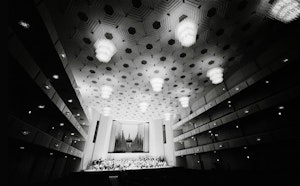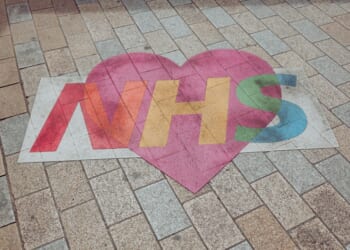This article is taken from the April 2025 issue of The Critic. To get the full magazine why not subscribe? Right now we’re offering five issues for just £10.
A week after Donald J. Trump declared himself president of the John F. Kennedy Center for Performing Arts, a bomb threat was received. The building was evacuated, searched and pronounced safe. Minor incident, they said. Some crackpot offering to blow up the Center was no big deal once the president had already done just that.
Democracy has a long-standing consensus that serving politicians don’t get hands-on with the arts. Maybe Trump didn’t know that when he sacked the KenCen chairman David Rubenstein and the board, followed by CEO Deborah Rutter.
Rubenstein, a business pal of Trump’s, had pumped a hundred million dollars into the Center. Rutter raised fifty million more each year. Where the next donors will come from is unclear. Trump is not a patron of the arts, nor even a fan. He never went to Kennedy, he said, because “there was nothing I wanted to see”.
“The Kennedy Center learned the hard way that if you go woke, you will go broke,” trilled a White House press secretary, making a point that the arts had oversold equity politics. Barely were her words online than gay shows were scrapped in DC. Opera diva Renée Fleming quit as a KenCen advisor. The conductor Leonard Slatkin warned of “an intrusive society and an offensive state”.
London’s Southbank Centre is a stinking failure, reeking of fast food and spilled beer
Most artists, though, kept shtum. With four years to go, the arts are terrified what Trump might do next, and where. Italy, Hungary, Slovakia and Turkey have already tightened a noose around arts necks. Argentina will follow. Authoritarian states want to control what we see and hear.
Yet — and this is a very big yet — there is just enough method in the Trumpian mayhem to suggest the possibility of positive outcomes. We have heard too much moralising from arts leaders. Arts centres have long been bastions of political correctness. Time, maybe, for a correction?
The arts centre as a concept stems from the 1950s when cities rebuilt concert halls from bomb rubble and it seemed efficient to site all arts together in a concrete bowl. Richard Wagner’s Gesamtkunstwerk was the ideal, but the centres were designed by the same tone-deaf brutalists who housed young families in tower blocks where the lifts never worked.
London’s Southbank Centre is the worst example. A Royal Festival Hall, unfit for symphonic purpose, was augmented by two chamber spaces, a dismal arts gallery and walkways that invited crime and injury. Officials offered ever more ridiculous remedies. One involved a £70 million glass roof which would have created the world’s biggest pigeon lavatory, costing millions to keep clean.
The South Bank these days is a stinking failure, reeking of fast food and spilled beer. Orchestral music, its core mission, can barely be located on its website.
A short ride up the Thames, the Barbican Centre has clunky sound and no creative coherence, jumbling concert music with random theatre and gruesome post-modern art. A bid to build a better hall collapsed when Brexit drove donors away. London is now collaging a third arts centre on the 2012 Olympics site with two museums, a dance hub and a BBC orchestra studio. When will we ever learn?
Other cities did. Paris stripped out extra-musical distractions from the Philharmonie concert complex, giving its orchestra home rule. Berlin has rejected arts coordination, drawing energy from the fierce autonomy of three opera houses and six orchestras. No arts centres here.
The American scene varies. At New York’s Lincoln Center, two big beasts — the New York Philharmonic and the Metropolitan Opera — ignore the landlords and get on with the art. In Los Angeles, the eye-catching Disney Hall was meant to rub shoulders with LA Opera, a theatre group and LA Dance, with the Colburn School and Broad Contemporary Art Museum across South Grand venue.
In practice, Gustavo Dudamel’s LA Philharmonic is the only big player in town. The other arts dance around the orchestra, praying for rain. Philadelphia’s Kimmel Centre houses a world-class orchestra and not much else. Its forecourt, deserted in daytime, is a vivid indictment of the failure of arts-centre theory to adjust to twenty-first century reality.

Which brings us back to Kennedy. The DC arts centre, envisaged by Eleanor Roosevelt, enacted by Dwight D. Eisenhower and named for his slain successor, was meant “to invite art into the lives of all Americans and ensure it represents the cultural diversity of America”.
That’s the dream on paper. It never worked. The KenCen houses a symphony orchestra and an opera company both of which have National in their title without ever being ranked among the nation’s top five. There is also a theatre, a digital movie house, an art gallery and more.
Over 57 years, and three chief executives, the Center has enjoyed highs and lows. Leonard Bernstein’s inaugural Mass was an appalling misconception. John Adams’s Nixon in China contrived against considerable odds to translate big-power diplomacy into durable art.
Such summits have been rare. The big show of the current season is “Earth to Space”, a three-week festival of performances, films, art, interactive exhibits and discussions “designed to ignite a sense of awe at the marvels of the universe”. Technology and ecology are the selling points. It has long been accepted that no one goes to Washington for artistic enlightenment.
And that’s where opportunity lies. It’s time to scrap the arts centre as a pulpit of social engineering and restore primacy to the people who make the art. Give the symphony orchestra control of the hall, the opera company of its stage and let a thousand flowers bloom. The arts centre is dead. Long live the performing arts.







